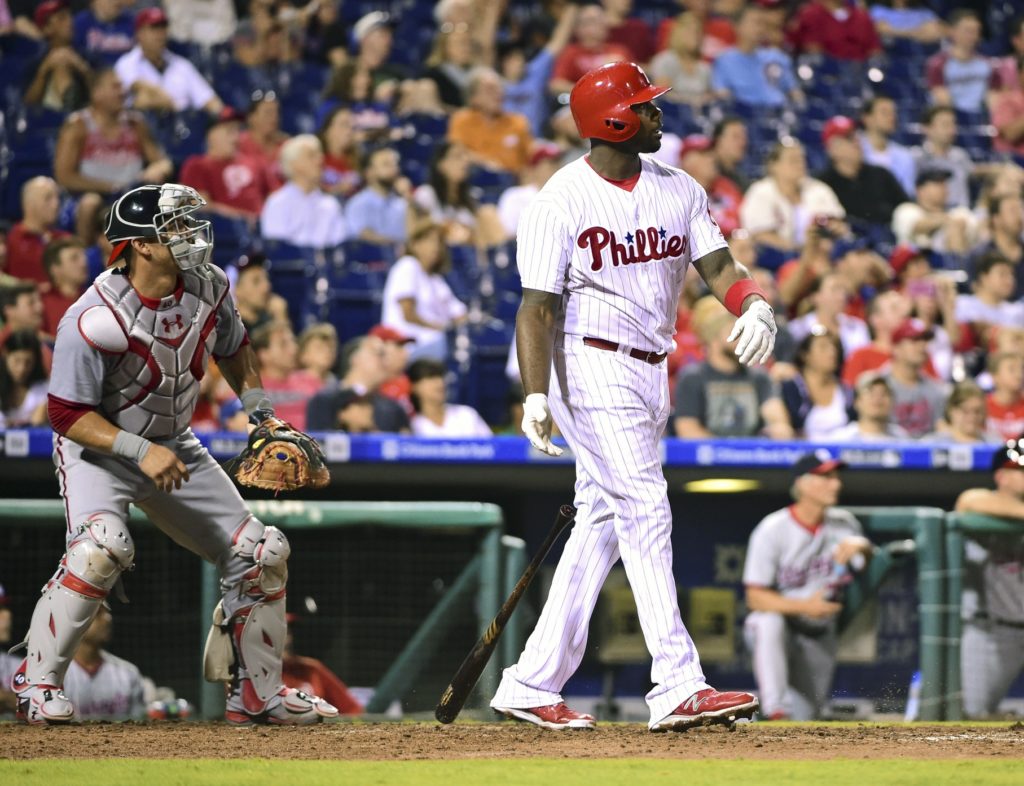Ad Disclosure
This Is a Gross Oversimplification of Ryan Howard’s Downfall
By Kyle Scott
Published:

FiveThirtyEight managed to stop writing about President Clinton* for a few days and has a piece up about how the shift killed Ryan Howard’s career:
When the shift is on, defenders move from one side of the infield to the other to give themselves a better chance at cutting off batted balls from hitters who consistently drive the ball in one direction. Howard was a great candidate for the maneuver because he pulled groundballs 66.5 percent of the time, compared to this year’s league average of 53.8. While some hitters try to overcome the shift with well-timed bunts or tactical changes, Howard always stubbornly refused. “All you can do is continue to swing,” Howard said in a 2015 interview with MLB.com.
That stubbornness proved to be Howard’s downfall. Against the shift, Howard posted a batting average of .282 and slugged .361, good for a weighted runs created plus that was 29 percent worse than average. When he wasn’t staring down the shift, Howard was a fearsome hitter with a .424 batting average, a .553 slugging percentage and a wRC+ 62 percent better than average (that wRC+ is identical to the one he posted in 2006, his MVP year).
…
Ortiz made an effort to adapt; Howard kept plugging away the way he always had. In the first eight years of his MLB career, Howard produced 21.6 wins above replacement.2 Over his final five seasons — a period during which use of the defensive shift increased exponentially — Howard was worth an astonishing 2.2 wins below replacement. Injuries also limited his productivity, but even when he was healthy, he was ineffective. As a slow, defensively-challenged first baseman, he relied on his bat to be useful. When the shift neutralized Howard’s hitting, he lost his value to a major league roster.
OK, all of that just made me angry at Ryan Howard again. But the article’s ultimate conclusion – that Howard could’ve been a hall of famer if not for the shift – is a gross oversimplification which reads like it was written by someone who didn’t live and die with each Ryan Howard-runners-in-scorin-position whiff.
The shift certainly hurt Howard, and the numbers bear that out, but he was also impacted by at least three other things: stubbornness, injuries, and a loss of power. As stated here, Howard refused to adjust to the shift. His approach at the plate not only didn’t improve, but perhaps got worse over the years. He struck out a league-leading 190 times in 2014. He also suffered multiple, substantial lower-body injuries starting in 2011. And as a result, he failed to eclipse 25 home runs every season since, this after six consecutive seasons of at least 30 or more home runs. His home run rate from was, for a few seasons, less than half of what it was at his peak.
Now, the shift can certainly be blamed for perhaps prematurely ending Howard’s career, since he became somewhat useless once he lost his fearsome power. But I do not buy the argument that it cost him a shot at the hall of fame or was the lone reason for his downfall these past few years.
Howard it seems never even attempted to change his approach at the plate. From 2006-2011, he was able to mask his weaknesses in the middle of a fearsome lineup. Once the pieces around him – Chase Utley, Jayson Werth, Pat Burrell – were stripped away, Howard became much easier to pitch to. He couldn’t run, couldn’t field, and couldn’t get on-base, only partly because of the shift.
*To be fair, FiveThirtyEight was one of the few sites that gave Trump a chance to win before the election.
Kyle Scott is the founder and editor of CrossingBroad.com. He has written for CBS Philly and Philly Voice, and been a panelist or contributor on NBC Sports Philly, FOX 29 and SNY TV, as well as a recurring guest on 97.5 The Fanatic, 94 WIP, 106.7 The Fan and other stations. He has more than 10 years experience running digital media properties and in online advertising and marketing.